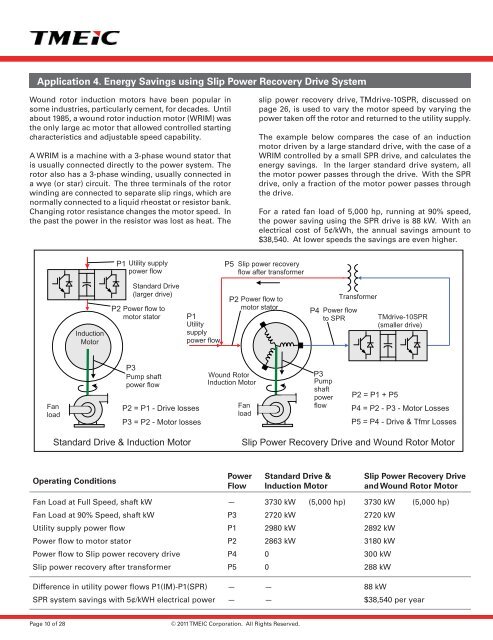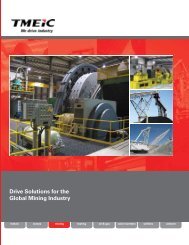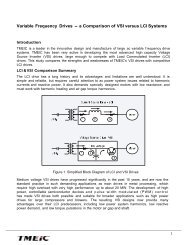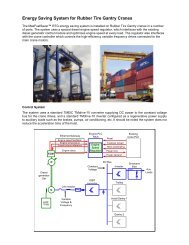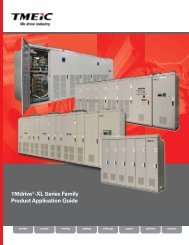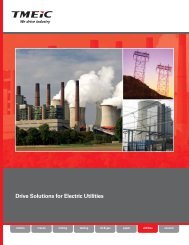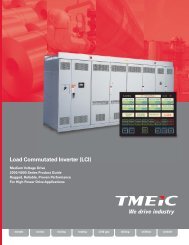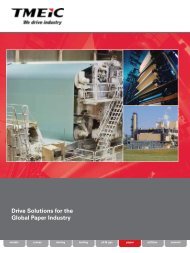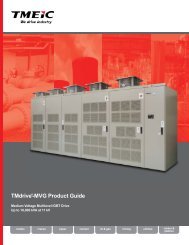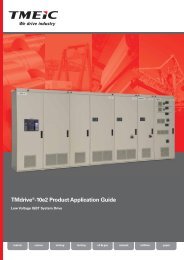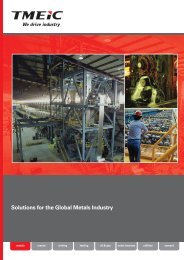Drive Solutions for the Global Cement Industry (email) - Tmeic.com
Drive Solutions for the Global Cement Industry (email) - Tmeic.com
Drive Solutions for the Global Cement Industry (email) - Tmeic.com
Create successful ePaper yourself
Turn your PDF publications into a flip-book with our unique Google optimized e-Paper software.
Application 4. Energy Savings using Slip Power Recovery <strong>Drive</strong> System<br />
Wound rotor induction motors have been popular in<br />
some industries, particularly cement, <strong>for</strong> decades. Until<br />
about 1985, a wound rotor induction motor (WRIM) was<br />
<strong>the</strong> only large ac motor that allowed controlled starting<br />
characteristics and adjustable speed capability.<br />
A WRIM is a machine with a 3-phase wound stator that<br />
is usually connected directly to <strong>the</strong> power system. The<br />
rotor also has a 3-phase winding, usually connected in<br />
a wye (or star) circuit. The three terminals of <strong>the</strong> rotor<br />
winding are connected to separate slip rings, which are<br />
normally connected to a liquid rheostat or resistor bank.<br />
Changing rotor resistance changes <strong>the</strong> motor speed. In<br />
<strong>the</strong> past <strong>the</strong> power in <strong>the</strong> resistor was lost as heat. The<br />
slip power recovery drive, TMdrive-10SPR, discussed on<br />
page 26, is used to vary <strong>the</strong> motor speed by varying <strong>the</strong><br />
power taken off <strong>the</strong> rotor and returned to <strong>the</strong> utility supply.<br />
The example below <strong>com</strong>pares <strong>the</strong> case of an induction<br />
motor driven by a large standard drive, with <strong>the</strong> case of a<br />
WRIM controlled by a small SPR drive, and calculates <strong>the</strong><br />
energy savings. In <strong>the</strong> larger standard drive system, all<br />
<strong>the</strong> motor power passes through <strong>the</strong> drive. With <strong>the</strong> SPR<br />
drive, only a fraction of <strong>the</strong> motor power passes through<br />
<strong>the</strong> drive.<br />
For a rated fan load of 5,000 hp, running at 90% speed,<br />
<strong>the</strong> power saving using <strong>the</strong> SPR drive is 88 kW. With an<br />
electrical cost of 5¢/kWh, <strong>the</strong> annual savings amount to<br />
$38,540. At lower speeds <strong>the</strong> savings are even higher.<br />
P1<br />
Utility supply<br />
power flow<br />
P5<br />
Slip power recovery<br />
flow after trans<strong>for</strong>mer<br />
Induction<br />
Motor<br />
Standard <strong>Drive</strong><br />
(larger drive)<br />
P2 Power flow to<br />
motor stator<br />
P1<br />
Utility<br />
supply<br />
power flow<br />
P2 Power flow to<br />
motor stator<br />
P4<br />
Trans<strong>for</strong>mer<br />
Power flow<br />
to SPR<br />
TMdrive-10SPR<br />
(smaller drive)<br />
Fan<br />
load<br />
P3<br />
Pump shaft<br />
power flow<br />
P2 = P1 - <strong>Drive</strong> losses<br />
P3 = P2 - Motor losses<br />
Wound Rotor<br />
Induction Motor<br />
Fan<br />
load<br />
P3<br />
Pump<br />
shaft<br />
power<br />
flow<br />
P2 = P1 + P5<br />
P4 = P2 - P3 - Motor Losses<br />
P5 = P4 - <strong>Drive</strong> & Tfmr Losses<br />
Standard <strong>Drive</strong> & Induction Motor<br />
Slip Power Recovery <strong>Drive</strong> and Wound Rotor Motor<br />
Operating Conditions<br />
Power<br />
Flow<br />
Standard <strong>Drive</strong> &<br />
Induction Motor<br />
Slip Power Recovery <strong>Drive</strong><br />
and Wound Rotor Motor<br />
Fan Load at Full Speed, shaft kW<br />
—<br />
3730 kW (5,000 hp)<br />
3730 kW (5,000 hp)<br />
Fan Load at 90% Speed, shaft kW<br />
P3<br />
2720 kW<br />
2720 kW<br />
Utility supply power flow<br />
P1<br />
2980 kW<br />
2892 kW<br />
Power flow to motor stator<br />
P2<br />
2863 kW<br />
3180 kW<br />
Power flow to Slip power recovery drive<br />
P4<br />
0<br />
300 kW<br />
Slip power recovery after trans<strong>for</strong>mer<br />
P5<br />
0<br />
288 kW<br />
Difference in utility power flows P1(IM)-P1(SPR)<br />
—<br />
—<br />
88 kW<br />
SPR system savings with 5¢/kWH electrical power<br />
—<br />
—<br />
$38,540 per year<br />
Page 10 of 28<br />
© 2011 TMEIC Corporation. All Rights Reserved.


